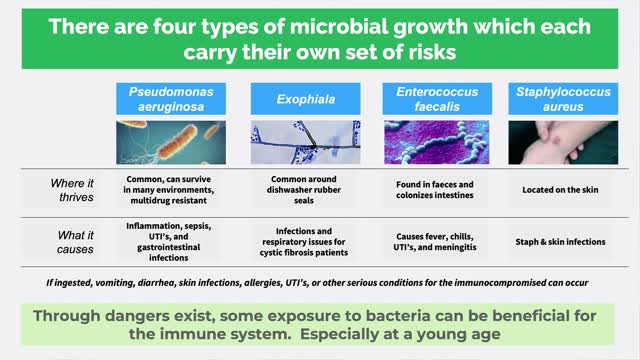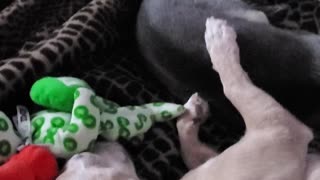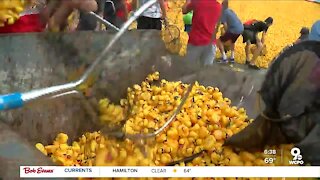Premium Only Content

The hidden horrors of rubber ducks, and how to keep yourself safe
Bathtime wouldn’t be the same without a rubber duck. For children, and maybe some adults too, the main attraction of a scrub in the tub is the chance to play with rubber or plastic bath toys, watching them bob amongst the bubbles and submerge amongst the suds. But beneath the cheery exterior of bright wide eyes and chirpy beak exists a hidden danger - one that could make you or your children very unwell.
The best way to investigate this is to chop them open (sorry, ducky), revealing the microbial growths that manifest inside. The initial findings are startling, showing a significant build-up of dark, murky slime, known as a biofilm. Biofilms are, in fact, a whole host of different microorganisms, including bacteria, fungi and moulds, that stick to each other and form a slimy substance to help them survive and multiply.
What’s shocking is that this is not just a one-off or a particularly old toy. Research found that 70% of bath toys contained the same black, slimy biofilm, and it could potentially be very harmful.
So, why does this biofilm grow inside of bath toys? One reason is the materials used. Plastic polymers leach biodegradable plasticizers and stabilizers which are used as a food source by microbes, giving them the fuel they need to multiply. On top of this, a combination of microbes from the building’s plumbing as well as additional nutrients and microbial contamination from the person bathing promotes microbial growth and biofilm formation inside the toys. All of these factors combine to create an environment in which the biofilm can survive and grow.
As unpleasant as biofilm sounds, the harm it can cause someone is even more severe. Because of the variety of microbes within the biofilm, there exists a range of dangers it can pose.
Pseudomonas aeruginosa, one of the microbes found in the biofilm, can cause inflammation and sepsis as well as urinary tract, skin and gastrointestinal infections.
Exophiala, also known as Black Yeast, can cause skin infections and is particularly dangerous to those who suffer from cystic fibrosis
Enterococcus faecalis, rather unpleasantly, is found in faeces. They can colonize the intestines and can cause fever, chills, urinary tract infections, gastrointestinal upset and meningitis.
Of course, environmental exposure to these microbes is very normal, but the danger lies in coming into contact with them in high concentration or ingesting them.
One of the best ways to keep bath times fun, yet safe, is to disinfect toys. However, disinfecting toys once will not prevent microbes from returning and growing again. It is still worth being vigilant, and maintaining a routine of drying the toys after use, boiling them, and then using a disinfectant product on them will help to ensure they stay clean and safe. Additionally, closing up any holes with a glue gun will stop any moisture from getting inside.
Perhaps most important is to use some common sense. Keep things as clean as possible, be aware of potential dangers even if they are hidden, and replace toys that are looking past their best, even if it is your favourite ducky.
Neu, L., Bänziger, C., Proctor, C.R. et al. Ugly ducklings—the dark side of plastic materials in contact with potable water. npj Biofilms Microbiomes 4, 7 (2018). https://doi.org/10.1038/s41522-018-0050-9
Neu, Lisa. (2020). Predicting and managing biofilm growth on flexible polymeric
materials in contact with drinking water. Doctoral Thesis. https://doi.org/10.3929/ethz-b-000440713
Stauber CE, Walters A, Fabiszewski de Aceituno AM, Sobsey MD. Bacterial contamination on household toys and association with water, sanitation and hygiene conditions in Honduras. Int J Environ Res Public Health. 2013;10(4):1586-1597. Published 2013 Apr 18. doi:10.3390/ijerph10041586
Zupančič J, Novak Babič M, Zalar P, Gunde-Cimerman N (2016) The Black Yeast Exophiala dermatitidis and Other Selected Opportunistic Human Fungal Pathogens Spread from Dishwashers to Kitchens. PLoS ONE 11(2): e0148166. https://doi.org/10.1371/journal.pone.0148166
Davies MW, Mehr S, Garland ST, Morley CJ. Bacterial colonization of toys in neonatal intensive care cots. Pediatrics. 2000 Aug;106(2):E18. doi: 10.1542/peds.106.2.e18. PMID: 10920174.
Strong, E. (2020). Yahoo is now a part of Verizon Media. Retrieved 24 November 2020, from https://www.yahoo.com/lifestyle/mom-warns-parents-hidden-dangers-bath-toys-son-nearly-loses-vision-145625143.html
Mitchell, A. (2020). Expert cuts open children's toys and shares horrifying results as warning to parents | The Morning Show. Retrieved 24 November 2020, from https://7news.com.au/the-morning-show/expert-cuts-open-childrens-toys-and-shares-horrifying-results-as-warning-to-parents-c-1633226?utm_campaign=share-icons&utm_source=facebook&utm_medium=social&tid=1606090947121&fbclid=IwAR134s5nSuPUGOtAEhFalrpfvXGoAoQsVW2IWx6VUQG5qS9XnhuN3_gcuno
-
 5:59
5:59
ViralHog
5 years ago $0.03 earnedBear Plays With Rubber Ducks in the Pond
1821 -
 0:11
0:11
GordonD
5 years agoKeep Your Hands to Yourself
71 -
 6:29
6:29
new feed
5 years agokeep yourself entertained
17 -
 4:35
4:35
Lynda Cromar Online Training
5 years agoKeep Yourself Positive Or You Can Take Yourself Down!!
48 -
 2:03
2:03
WCPO
5 years agoNo ducks in the water as Rubber Duck Regatta goes virtual
139 -
 2:09
2:09
NowYouKnowEnglish
5 years agoHow To Adjust Yourself To Retirement ?
33 -
 1:15
1:15
Prince1122
5 years ago $0.02 earnedHow to defend yourself
141 -
 0:15
0:15
ViralHog
6 years agoMagical Rubber Band
60 -
 1:44
1:44
WKBW
4 years agoHow to protect yourself from online shopping scams
100 -
 1:12
1:12
Etienne
5 years ago $0.24 earnedThe hidden
6162